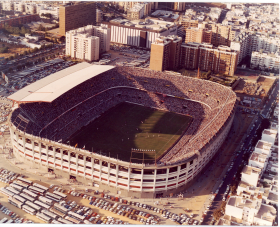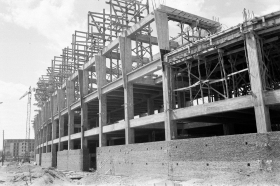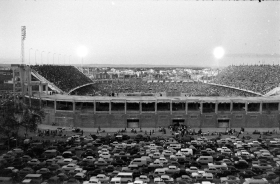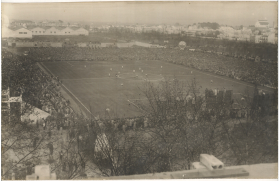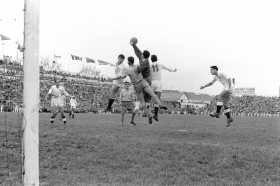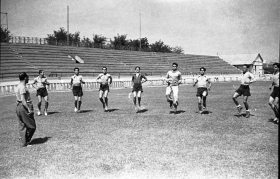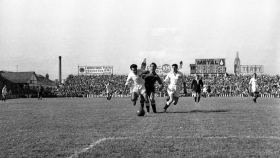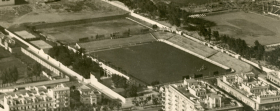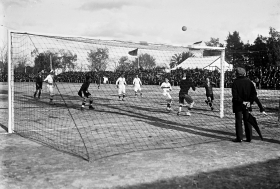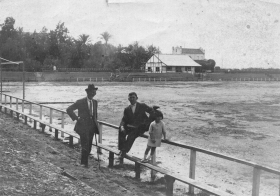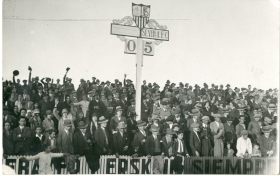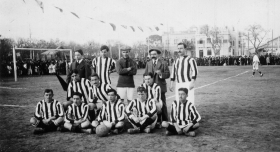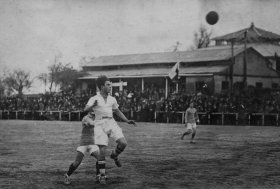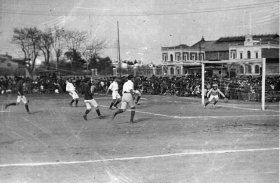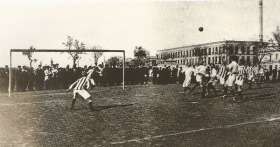Campos de juego de la historia
After 30 years, Viejo Nervión was starting to become too small and outdated. The new demands of football required comforts and capacities that the old stadium could not satisfy. That is why the Ramón Sánchez-Pizjuán Stadium was inaugurated on 7th September 1958, in a match against Real Jaén that ended in a three-goal draw. The new stadium was located next to the grounds of the old one.
The idea of building the new stadium was first mooted in November 1937, when Ramón Sánchez-Pizjuán negotiated with Pablo Armero the purchase of the Nervión stadium and an annex of 42,000 square metres, where the new stadium was to be built.
The project for this new stadium dates back to 1954. In January of that year, Sevilla FC organised a competition for ideas for the construction of a new stadium with a capacity of at least 50,000 spectators.
The competition was won by the architect Manuel Muñoz Monasterio, who had years earlier built the Santiago Bernabéu and Mestalla, and who was about to begin construction of the Ramón de Carranza in Cádiz. Thus, the architect from Madrid obtained the prize of 50,000 pesetas, the amount that the winning sketch was endowed with, and also received the commission for the final project.
The approved project consisted of a stadium with a capacity for 70,329 spectators, 20,329 seated and 50,000 standing, with the standing areas behind both goals and also in the upper tier of the Fondo Stand.
The sudden death of President Sánchez-Pizjuán, on 28 October 1956, prevented him from seeing his lifelong dream come true, but the Presidents who succeeded him, especially Ramón de Carranza and Gómez-Pablos, Marquis of Soto Hermoso, who promised over Sánchez-Pizjuán's dead body that his dream would come true, would take charge of the definitive construction of the stadium. On 2 December of the same year, 36 days after the death of the distinguished president, the first stone of the new stadium was laid. The stadium was built in a record time of 22 months and 6 days. The Ramón Sánchez-Pizjuán Stadium was inaugurated and opened to the public, without the upper tiers behind the goals and with the upper tier of the Main Stand only half finished. During that same season, the Main Stand was completed, but the stands behind the goals had to wait until 1975. In September 1959, a friendly match was played against Bayern Munich, an event that served to inaugurate the floodlights. The first electric lighting consisted of four towers installed in the corners of the stadium, the installation was entrusted to the company Abengoa and had a power of 250 LUX, which was almost double that of the best stadiums in Europe at the time.
The work was initially to be carried out by the company Agromán, but finally the proposal was accepted from the Catalan company Ingar, which had carried out the construction of FC Barcelona's Camp Nou and which offered the cheapest work and the best payment conditions. To cover the cost of the work, estimated at 50 million pesetas, 100,000 bonds were issued at a price of 500 pesetas. They were issued in equal shares by the Banco Español de Crédito and the Caja Provincial de Sevilla.
Between the latter months of 1974 and the start of 1975, the stadium was finally completed. The cost of the work amounted to 78 million pesetas. To pay for this amount, numerous "Row 0" tickets and symbolic tickets costing 50 and 100 pesetas were sold. The financial support of Gabriel Rojas was vital for the completion of this work. On 7th September 1975, the upper tier of Gol Sur was inaugurated in a match against Las Palmas, while on 26th October 1975, the upper tier of Gol Norte was inaugurated in a match against Valencia CF.
In 1982, due to legal provisions, its capacity was reduced to 66,000 spectators, and a large part of the stadium was remodelled to host a semi-final of the 1982 World Cup, specifically the France-Germany match. The fences installed in the 1970s were removed and a moat was built around the pitch. The Main Stand roof was built and the artist Santiago del Campo built a majestic monumental mosaic on the façade of the Main Stand. The cost of these works amounted to 400 million pesetas.
In 1986, on 21st April, the European Cup final between FC Barcelona and the Romanian team Steaua Bucharest took place.
In 1996, UEFA decreed that all stadiums must be all-seater. As a result, the capacity of the Ramón Sánchez-Pizjuán was considerably reduced to 42,714.
In 2015, a new comprehensive refurbishment work began. Among other interventions, the following are included: replacement of the colour of the seats, most of which are now red; covering of the outer façade with a metallic skin with LED lighting; renovation of all the stadium bars and toilets; installation of two new video scoreboards; replacement of the separation fences between stands with glass, etc.The refurbishment work is currently continuing.
In 2022, on 18th May, the stadium hosted the UEFA Europa League final between Glasgow Rangers FC and Eintracht Frankfurt. In this way, the Ramón Sánchez-Pizjuán became one of only six major European stadiums to host the single-leg final of the two main UEFA club competitions.
Finally, it should be added that the Spanish national team has not lost a single match at the Ramón Sánchez-Pizjuán Stadium, from the first match played in 1961 to the last one in 2015. In total there have been 25 matches, with a record of 20 wins and 5 draws, and the stadium has been formally designated as Player Number 12 by the RFEF.
In 1928, under the presidency of Juan Domínguez Orborne, Baron de Gracia Real, a 14,300 square metre plot of land belonging to the Nervión real estate company was leased to Pablo Armero, Marquis of Nervión, where the Nervión Stadium was to be built. To pay the rent for the land and the construction of the stadium, a certain number of bonds were issued at a price of five pesetas. The debentures were issued on 15 July 1928. The maturity date for the annual draw of 2,000 bonds was 31 July 1929 and the following years until ten years were completed. During the season the holders of these shares could exchange them for preferential tickets, although they forfeited the interest which was set at 5% per annum.
Renting this plot of land was really expensive and the construction of the stadium itself was much more costly. In the minutes of a board of directors meeting in March 1928, we read that the Marquis of Nervion offered a plot of land some 600 metres from the San Bernardo Bridge, under the following conditions: annual rent of 5,000 pesetas and construction of the pitch (fencing and stands) for 100,000 pesetas to be paid over ten years.
The truth is that not many bonds were sold and the president had to advance a large amount of money to carry out that great work, money that the president paid back in easy instalments that he collected after the matches were played. Sometimes he received 2,000 pesetas, sometimes 3,500 pesetas, and so on until the total of the money advanced was reached. The manager in charge of the treasury set aside the usual expenses for the match schedule and the surplus was divided into two parts, one to pay the players and coach and the other to reduce the debt contracted with the Baron of Gracia Real.
The Nervión Stadium was built on this land and was inaugurated on 7 October 1928 in a match against Real Betis Balompié.
Its capacity was initially 12,000 seats. Later it was increased to 20,000 seats and in special circumstances such as European Cup matches or matches against big rivals, the stadium could hold up to 27,000 seats.
A key date for this stadium is 29 April 1938, when, as President of Sevilla, Ramón Sánchez-Pizjuán signed the deeds for the purchase of the land occupied by the stadium. Sevilla acquired not only the land where the Nervión stadium was located, but also 42,000 m2 more in the surrounding area for the construction of a new stadium and the construction of other facilities for the practice of other sports. In addition to the main pitch, besides the dressing room and the snack bar, a training pitch (also known as the Subcommittee pitch), two tennis courts and a pelota court were also built. The 14,300 m2 occupied by the Nervión Stadium were bought at a price of seven pesetas per square metre, the 42,000 adjacent at a price of nine pesetas per square metre.
The amount of the purchase was 429,000 pesetas. In order to cover this purchase, new bonds were issued at a price of 500 pesetas.
The Nervión Stadium will always be remembered for the great successes that Sevilla FC achieved there. A League Championship and three Spanish Cups, as well as six Andalusian Cups and Sevilla's first participation in the European Cup, today the Champions League.
The Nervión Stadium also hosted a Spanish national team match on 15 March 1942, with the result Spain 4-0 France.
In 1918, due to the redevelopment work that Sevilla City Council had to carry out in Prado de San Sebastián for the future Ibero-American Exhibition, both Sevilla FC and the rest of Sevilla's clubs were forced to abandon their grounds there.
Sevilla FC were forced to look for a new site, and to do so, set up a committee made up of several members of the board of directors, who visited the mayor of the city in an attempt to obtain a municipal plot of land for the club, but the negotiations proved unsuccessful. After this, various sites were considered, including a plot of land in Nervión, just where the old slaughterhouse was located, which is now the Delegation of Education of the Andalusian Regional Government, although in the end a large plot of land on Avenida de la Reina Victoria, now Avenida de La Palmera, was chosen.
The so-called "Campo de Sport del Sevilla FC de la Avenida de la Reina Victoria" was inaugurated on 21 October 1918.It was built after an agreement was reached between President Paco Alba - and the aforementioned commission - and the Marquise of Esquivel, María del Pilar de Carvajal Hurtado de Mendoza, to lease part of the land she owned on the estate known as Casablanca, located at the foot of the Paseo de la Palmera. The son of the Marquise, who was a great football fan and a great Sevillista, managed to convince his mother not to make the rent too expensive, setting an annual amount of 2,000 pesetas. For the second time in its history, the club built its stadium with its own funds. To finance the stadium, the club put 100 bonds up for sale, at a price of 100 pesetas each, to be repaid over five years.
The costs of the construction of the stadium were distributed among different items. 1,350 pesetas for the fencing (dismantling of the fence of the previous Mercantil pitch and its subsequent assembly in the new location) and the levelling of the pitch, work carried out by Manuel Domínguez. In addition, the carpenter José Grosso Barba surrounded the pitch with wooden benches and built a small grandstand 10 metres long, as well as four stands for seating at a price of 6.75 pesetas per square metre.
Finally, a stand was built for 3,000 pesetas, designed and executed by the architect Pablo Gutiérrez.
The hut was used as a changing room and as a house for the groundsman, initially occupied by Eduardo Santizo, father of the player of the same name, and later by Manuel Pérez, El Terrible, a former player of the Club and the first of the Pérez family, so closely linked to Sevilla FC up to the present day. But the hut was not only the groundsman and dressing room, as part of it was also used as a room for the club's medical service, something new at the time, which was taken care of by Dr. Puelles de los Santos. For the first time in the history of stadia in Sevilla, the changing rooms housed a shower.
"...The pitch has undergone some good renovations this year. Pérez has definitively stayed on as groudnsman and will live in the new clubhouse that has been built out of material, at the back of which a room has been made for him to live in with his wife and children.
The room he had before will be used as an infirmary and the same massage apparatus will be installed. The doctor is Mr. José Puelles de los Santos. The first team players have their room with 15 hangers for their equipment and their shower and washbasin (...) The other room is for the board of directors..." (Letter from the club secretary Manuel Zapata to the player Ismael Rubio).
The pitch was equipped with all the necessary elements for the good practice of football. It had stands on all four sides of the ground, and was completely enclosed.
The inauguration took place with a match between Sevilla FC and Unión Sporting Club de Madrid. The first season the following prices were established for the public: Grandstand: 1st row 10 pesetas, 2nd row 9 pesetas, 3rd row 8 pesetas, Row of benches 5 pesetas. The membership fee went up from 2 to 3 pesetas a month.
In 1924, the president Manuel Blasco Garzón carried out another reform, placing two new side stands with new access embankments and achieving a capacity of more than twelve thousand seats.
This stadium achieved great fame, because it was here that Sevilla FC demonstrated its supremacy in Andalusian football, winning up to nine Andalusian Championships. The first match of the Spanish National Team in Andalusia was played here on 16 December 1923, against Portugal, where Spain won 3-0, also producing the international debut of the first two Sevilla players: Spencer and Herminio. On 10 May 1925, it hosted the final of the Spanish Championship between FC Barcelona and Arenas de Guecho.
In 1926 the lease period expired and a moratorium of two more years was reached. During this time, Sevilla FC had up to three fronts open for the acquisition of a new stadium. One of them was in the area of the planned Los Remedios neighbourhood, but it was not carried out due to the refusal of the Ibero-American Exhibition Committee to provide the necessary subsidies to the construction company of Mr. and Mrs. Goizueta. This was due to the fact that the aforementioned committee intended to build the Stadium - as was the case - in the southern sector of the city. The acquisition of some land owned by Genaro Parladé in front of the field on Avenida Reina Victoria was also negotiated, but this did not come to fruition as no economic agreement was reached. Finally, the offer made by the Exhibition Committee itself for Sevilla to take over the operation of the aforementioned Stadium after the Ibero-American Exhibition was studied. Talks in the latter case were held until months before the decision to move to Nervión in 1928.
At the end of the 19th century, relations between the Círculo Mercantil and Sevilla FC were of capital importance. The members of the Mercantile, with its president Montes Sierra at the head, represented an important bastion in the regenerationist current that arrived like a breath of fresh air from Europe.
Sevilla FC fully shared these ideals and many of its members were members of the Círculo. Edward Johnston, Hugo Maccoll, Isaias White and a long etcetera, including José Luis Gallegos, maintained excellent relations with Montes Sierra, and José Luis Gallegos, who became responsible for the Festivities and Library Section of the Mercantil, became especially close friends. This collaboration would result in the development of sport in both institutions and the promotion of sport among the city's inhabitants.
Sevilla FC's secretary's office was set up in the Mercantil's premises, and a Feria tent in Prado de San Sebastián was used as a makeshift changing room in the old stadium. It was one of the members of the Círculo Mercantil itself, the Catalan José María Miró Trepats, at that time President of Sevilla FC, who, with great experience in the management of sports clubs in Catalonia, began negotiations with the City Council for the transfer, after the corresponding annual payment of taxes and municipal fees, of the land behind the permanent Feria tent that the Círculo Mercantil owned in Prado de San Sebastián.
All this took place at the end of 1912, and on 1 January 1913 the inauguration of what will always be remembered as Sevilla's Mercantil Stadium was achieved.
At first, the stadium was open and admission was free. A metal grandstand was prepared as an extension of the Feria tent and served as a support for the roof that provided protection for the members. A removable wire fence was installed around the pitch, supported by cast iron posts made by the Balbontín company.
For the inauguration, a decoration of garlands and flags was prepared and from very early in the morning, the municipal band provided entertainment for the event. The inaugural match was played by two teams from Sevilla FC - the so-called red team, although they actually wore red and white striped shirts, against the white team - and the match ended in a 1-1 draw. The president Miró Trepats gave an emotional speech at the dinner following the inauguration, of which it is worth remembering these beautiful words:
"You represent joy, health, strength and robustness; in our meetings we do not talk about politics, in the heart of our sport society there is room for the poor and the rich alike, even our fans are a reflection of our sport society, because at our stadium people from all social classes rub shoulders and you should be praised, because you have discipline as a rule, victory as an ideal, strength is our aspiration and the admiration of others is our reward".
At that time, the pitch was the only one in the city that had the right size and conditions for important matches. At the same time, the seats around the pitch were rented out, which led to the first box office income.
On 16 October 1916, after raising a large sum of money from the club's members, the pitch was surrounded by a 2.5m fence painted red, hence its other nickname: the stadium of the red boards. The boards were numbered to facilitate dismantling and subsequent reassembly when the grounds needed to be vacated during the Feria de Abril. The Campo del Mercantil was maintained until the summer of 1918, witnessing great triumphs in the Sevilla Cup and the Andalusian and Spanish championships, as well as the beginnings of what would later be known as the Sevillista School.
Around 1910, and after several locations next to the walls of the María Luisa Park, a new site was chosen: opposite the Engineers headquarters, on part of the land that would later become the Plaza de España.
The club then moved its sports facilities, which consisted of the goal posts and the ball, which was kept in a nearby kiosk that also served as a changing room.
At an assembly of Sevilla FC in 1909, under the presidency of José Luis Gallegos, the following agreement, among others, was adopted:>
"It is agreed that a committee should visit the Civil Governor to ask him to adopt the measures he deems appropriate so that neither the players nor the public suffer the inconvenience caused by a party of Zulus parked in the vicinity of the pitch during matches...".
The pitch was not enclosed and the playing area was made up of wooden posts and ropes.



 Spanish
Spanish
 English
English
 عربي
عربي
 中文
中文
 日本語
日本語
